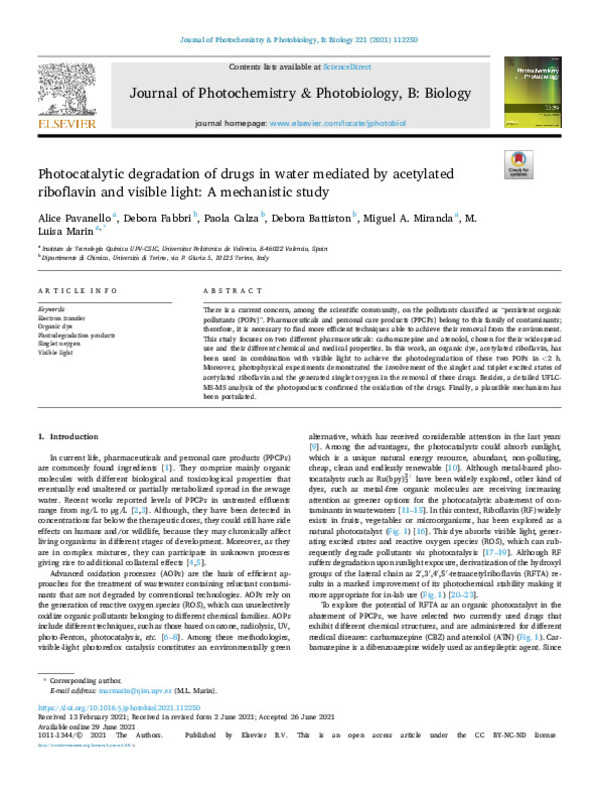Pavanello, A.; Fabbri, D.; Calza, P.; Battiston, D.; Miranda Alonso, MÁ.; Marín García, ML. (2021). Photocatalytic degradation of drugs in water mediated by acetylated riboflavin and visible light: A mechanistic study. Journal of Photochemistry and Photobiology B Biology. 221:1-11. https://doi.org/10.1016/j.jphotobiol.2021.112250
Por favor, use este identificador para citar o enlazar este ítem: http://hdl.handle.net/10251/189482
|
Título:
|
Photocatalytic degradation of drugs in water mediated by acetylated riboflavin and visible light: A mechanistic study
|
|
Autor:
|
Pavanello, Alice
Fabbri, Debora
Calza, Paola
Battiston, Debora
 Miranda Alonso, Miguel Ángel
Miranda Alonso, Miguel Ángel

 Marín García, Mª Luisa
Marín García, Mª Luisa
|
|
Entidad UPV:
|
Universitat Politècnica de València. Escuela Técnica Superior de Ingenieros Industriales - Escola Tècnica Superior d'Enginyers Industrials
|
|
Fecha difusión:
|
|
|
Resumen:
|
[EN] There is a current concern, among the scientific community, on the pollutants classified as "persistent organic pollutants (POPs)". Pharmaceuticals and personal care products (PPCPs) belong to this family of contaminants; ...[+]
[EN] There is a current concern, among the scientific community, on the pollutants classified as "persistent organic pollutants (POPs)". Pharmaceuticals and personal care products (PPCPs) belong to this family of contaminants; therefore, it is necessary to find more efficient techniques able to achieve their removal from the environment. This study focuses on two different pharmaceuticals: carbamazepine and atenolol, chosen for their widespread use and their different chemical and medical properties. In this work, an organic dye, acetylated riboflavin, has been used in combination with visible light to achieve the photodegradation of these two POPs in <2 h. Moreover, photophysical experiments demonstrated the involvement of the singlet and triplet excited states of acetylated riboflavin and the generated singlet oxygen in the removal of these drugs. Besides, a detailed UFLCMS-MS analysis of the photoproducts confirmed the oxidation of the drugs. Finally, a plausible mechanism has been postulated
[-]
|
|
Palabras clave:
|
Electron transfer
,
Organic dye
,
Photodegradation products
,
Singlet oxygen
,
Visible light
|
|
Derechos de uso:
|
Reconocimiento - No comercial - Sin obra derivada (by-nc-nd)
|
|
Fuente:
|
Journal of Photochemistry and Photobiology B Biology. (issn:
1011-1344
)
|
|
DOI:
|
10.1016/j.jphotobiol.2021.112250
|
|
Editorial:
|
Elsevier
|
|
Versión del editor:
|
https://doi.org/10.1016/j.jphotobiol.2021.112250
|
|
Código del Proyecto:
|
info:eu-repo/grantAgreement/AEI/Plan Estatal de Investigación Científica y Técnica y de Innovación 2017-2020/PID2019-110441RB-C33/ES/SINTESIS, CARACTERIZACION Y EVALUACION DE NUEVOS FOTOCATALIZADORES: ANALISIS DE PATOGENOS MICROBIANOS Y MICROCONTAMINANTES ORGANICOS COMO INDICADORES DE CALIDAD/
info:eu-repo/grantAgreement/GENERALITAT VALENCIANA//PROMETEO%2F2017%2F075//REACCIONES FOTOQUIMICAS DE BIOMOLECULAS./
info:eu-repo/grantAgreement/EC/H2020/765860/EU
|
|
Agradecimientos:
|
Financial support from H2020/Marie SkodowskaCurie Actions under the AQUAlity project (Reference: 765860) , Conselleria d'Educacio, Investigacio, Cultura i Esport (PROMETEO/2017/075) and the Spanish Ministry of Science, ...[+]
Financial support from H2020/Marie SkodowskaCurie Actions under the AQUAlity project (Reference: 765860) , Conselleria d'Educacio, Investigacio, Cultura i Esport (PROMETEO/2017/075) and the Spanish Ministry of Science, Innovation and Universities (PID2019-110441RB-C33) is gratefully acknowledged.
[-]
|
|
Tipo:
|
Artículo
|









